|
|
|||
 |
Department of Engineering |
| University of Cambridge > Engineering Department > Photo competition |
 |
Ben Sheppard and Robert Howshall Project Pebble In 2009 a small team at the Department of Engineering designed and built a low-cost, deep-sea photographic vessel. This photograph shows "Pebble" undergoing pool trials at Cranfield University. Whilst deep-sea photography has been done before, Pebble differed in one key respect. Cost. Pebble was built for £1800, making her tens of times less expensive than comparable deep-sea craft. This was achieved by using off-the-shelf components, almost no moving parts, and a pressure-balanced design. It is planned that subsequent years of Cambridge undergraduate engineers will improve the design and reduce the cost to less than £1000, making deep sea photography more affordable than ever before. Project Pebble was sponsored by BAE Systems Submarine Solutions, and supported by Tritech International, EADS, and Pentax. More information on the project along with a gallery of photos can be found at: www.projectpebble.co.uk Click on the image to see a larger version. |
|
2nd prize |
||
 |
Ivan Minev and Rami Louca Synapse In his research Ivan uses techniques developed by the semiconductor industry and apply them to soft materials that can be flexed and stretched. This novel approach will help to bridge the gap between rigid electronics and that of soft, living matter. Ivan will explore applications in prosthetics and tissue engineering. This Scanning Electron Microscope micrograph illustrates an experiment where Ivan fabricated a matrix of micro features. The features are small enough for biological cells to detect and interact with. This would enable Ivan and his team to study how the surrounding environment influences the many decisions a cell needs to make during its life cycle. The image invokes analogies with a neural circuit. You can see several 'neurons'; their cell bodies are large and round. They even project axons which join together in a synapse, the site where the electrical signal from one neuron jumps to the next. Click on the image to see a larger version. |
|
3rd prize |
||
 |
Isil Ayranci Kilinc Rumble The array of images shows an aero-engine gas turbine burner flame oscillating due to self-excited combustion instabilities at low frequency which is a state termed as 'rumble'. The flow direction is from left to right and flame is observed to oscillate between a blue/violet lean premixed combustion mode and a brushy turbulent diffusion flame characterized by bright yellow soot incandescence. The frames were captured from a digital video recorded at Cambridge Intermediate Pressure Combustion Facility (CIPCF) during experimental investigation of combustion instabilities on a prototype low-NOx lean direct injection (LDI) burner. LDI technology offers a strong potential to reduce aircraft pollutant emissions but lean burn conditions are prone to combustion instabilities which have to be eliminated as they may damage engine parts by inducing acoustic resonance. CIPCF is funded by EPSRC and Rolls Royce plc. Click on the image to see a larger version. |
|
Other entries |
||
 |
Daniel Strange Teddies in Space Four teddy bears voyaged to the edge of space on Monday December 1st 2008 as an experiment run by Cambridge University Spaceflight, with the SPARKS science club at Parkside Community College and Coleridge Community College. The bears were lifted to 30,085 metres above sea level on a latex high altitude balloon filled with helium. The aim of the experiment was to determine which materials provided the best insulation against the -53 ° C temperatures experienced during the journey. Each of the bears wore a different space suit designed by the 11-13 year olds from SPARKS. Click on the image to see a larger version. |
|
 |
Rachel Milford Iceberg in the Gerlache, Antarctica We hoped to sail down one of the smaller straits but found it was too full of ice for us to proceed. One of the icebergs we navigated around was particularly beautiful showing sun scallops and bubble rills. Click on the image to see a larger version. |
|
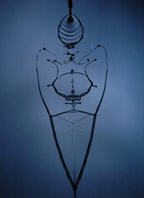 |
Sungjune Jung Fluid Instability This image, taken using a Nikon D40X with a 105mm lens and a Xenon flash lamp with ~1us duration, shows an unstable flow structure generated from the collision of two impinging jets with the diameter of 0.85mm. Click on the image to see a larger version. |
|
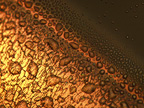 |
Ingrid Graz Leopard "The photo shows all amorphous carbon (diamond-like carbon) deposited on glass respectively elastomeric subtrates. We investigate this material for its use in stretchable electronics as it will withstand when correctly designed large strains and thus protect fragile devices prepared on top of it. Shows gold films on elastomeric substrates to serve as stretchable electrodes. Click on the image to see a larger version. |
|
 |
Charlie Watt and Jonny Mullin Splash Splash is a concept lightweight tension structure designed to be an exhibition space next to the mill pond. The concept is inspired by the shapes produced by flowing water and impacting water drops. The model (shown in the photo) was constructed, using mostly wire and tights, as part of the third year structural design project. A photo of the model has been added to the photo of mill pond using PhotoShop. Click on the image to see a larger version. |
|
 |
Malik Qasim Saturn's ring arc Liquid crystalline molecules are very fascinating compounds and conceal the whole colourful universe with in. They reveal these mesmerising, beautiful textures under polarised microscope and lead eye blink to languish. These photographs have been taken under hot stage polarised microscope at certain temperature rang using normal aliened glass cell. These snaps show the transitions before the sample went under isotropic liquid phase and the titles are given on their manifestations. Furthermore, no digital or non-digital enhancement has been carried out on these pictures. Acknowledgement: I am thankful to Prof. Harry Coles for his support and encouragement and thanks to members of the Centre of Molecular Materials for Photonics and Electronics for providing me friendly environment. Click on the image to see a larger version. |
|
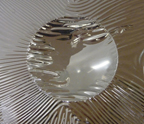 |
Arnaud Bonin Wrinkled circle Experiment analysing the effects of pressure on the out-of-plane deformation of a thin Kapton membrane. The wrinkling behaviour is studied to understand how this reflective membrane can become the primary mirror of a future space-bound telescope. The picture was cropped by cutting one side of it and a “air hole” in the middle was deleted. Click on the image to see a larger version. |
|
 |
Hugh Hunt Launch Pad Debris After a failed rocket launch (the motor exploded on takeoff) this black sticky splodge of debris was left behind on on the launch pad. Click on the image to see a larger version. |
|
 |
Rami R M Louca Giant's causeway SEM micrograph of Zinc oxide micro crystals. Not enhanced in any way. Acknowledgements: Prof. M Welland, Dr. James Bendall, Dr. Natalie Plank Click on the image to see a larger version. |
|
 |
Tim Wilkinson CNT wall An LC/CNT device is a hybrid liquid crystal/carbon nanotube device filled with a standard nematic LC viewed under reflected polarised light a x20 magnification. The device is viewed from above and is two parallel walls of CNTs (the top of the T - shaped electrodes). Click on the image to see a larger version. |
|
 |
Jonathan Mullin Purity A single drop hangs in time above a bowl of water, disturbed moments earlier by a previous droplet. Click on the image to see a larger version. |
|
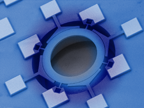 |
Angel Lin Ring Microbalance This image is a miniaturized silicon ring resonator, taken using scanning electron microscope. The resonator is electrically excited by the surrounding electrodes and is used as highly sensitive mass sensor, hence called a microbalance. The resonator was designed by Joshua Lee, and the image has been coloured by Yunie Li using Adobe photoshop. Click on the image to see a larger version. |
|
 |
Philip Hands Cooling Cholesteric This photograph was taken using an optical polarising microscope of a chiral nematic (cholesteric) liquid crystal cell. The images were taken whilst the cell was cooled from the isotropic to the chiral nematic phase. Between 99 and 104 deg C. Click on the image to see a larger version. |
|
 |
Theo Hacking Bridge building in Morocco In 2003 I attended the International Association for Impact Assessment (IAIA) conference in Marrakech. The conference was the first I attended after starting my PhD at the Centre for Sustainable Development, Department of Engineering. I went on one of the post-conference events, which involved a day trip to the foothills of the Atlas mountains. While walking to the waterfalls we came across the boys, who I think are Berber. I was intrigued by their ‘engineering’ efforts and the general excitement that surrounded this. It was a stroke of good fortune that the one boy stood up with an excited expression just as I was taking the picture. I had forgotten about the picture, but recently came across it while sorting through my things. Click on the image to see a larger version. |
|
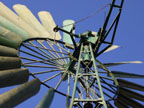 |
Sam Cocks Wind pump This machine has been diligently supplying water to its Kenyan farm for nearly two decades, allowing irrigation and sustaining generations of livestock. Its reliability in providing this simple but essential function is a testament to practical engineering solutions. Click on the image to see a larger version. |
|
 |
Stephen Morris Liquid crystal laser array Image is a two-dimensional array of red-green-blue liquid crystal lasers constructed from a single liquid crystal device. This device emits all three colours simultaneously. Click on the image to see a larger version. |
|
 |
Olusomi Delano Cranes and a digger Like everywhere else in Dubai, construction was taking place on reclaimed land. In the summer of 2008, I was on a 3 week work placement with Ramboll Whitbybird and visited this site. This project started in Summer of 2007 and was set to finish in the Summer of 2009; I could not see how this was possible but then again it's Dubai, impossible is nothing. Click on the image to see a larger version. |
|
 |
Damian Gardiner Molecular Flowers The image presented is observed because of electro-hydrodynamic instabilities within a liquid crystal phase. These are initially very chaotic but assume more and more order as the voltage is increased - hence the amazing (and initially unanticipated) patterns observed. The picture was taken between crossed polarisers and has been adjusted for tone. Click on the image to see a larger version. |
|
 |
Martin Bohmert Between Tradition and Modernity This is the Millenium Bridge in London which had some troubles when it first opened, but it is now a very nice part of the ballad along the Thames. Click on the image to see a larger version. |
|
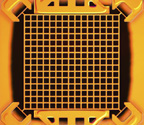 |
Jize Yan Blinking buttons An original micrograph of a micro-machined Silicon in-plane mode square-plate resonator with regular process etching holes. Micro-Electro-Mechanical Systems (MEMS) is the integration of mechanical elements, sensors, actuators, and electronics on a common silicon substrate through microfabrication technology. MEMS resonators are currently being developed for signal processing and sensor applications, such as in oscillators, electronic filters, inertial sensors, and mass sensors, due to their small scale, potential for system-on-chip integration with CMOS circuits and the capability to process signals at very low power levels. Click on the image to see a larger version. |
|
 |
Hugo Mallinson Getting Ready to Move The Institute for Manufacturing Automation Lab in the middle of being broken down for the move to the new building. This photo is a composition of 76 smaller photographs. Click on the image to see a larger version. |
|
 |
Haider Butt Optical antenna array The picture shows the localisation of light at a sub-wavelength scale of a few micrometers by a phased array of dipole antennas. This simulation models an array of carbon nanotubes as optical antennas, converting the incident light waves into localised energy. |
|
 |
Georgina Rose 8 weeks relevant industrial experience "This photo was taken in Chiang Rai, Northern Thailand, where I spent 2 months working on the full construction project of a reinforced concrete bridge. The nature of the work was such that it was “of an engineering nature involving other people in an engineering environment” and thus qualified me for my 8 weeks industrial experience requirement for part IB of the Cambridge Engineering Tripos. I think the photo highlights the opportunities undergraduate engineering can offer beyond the Department of Engineering." Click on the image to see a larger version. |
|
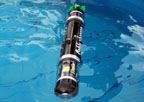 |
Paul Esparon Blackghost The photo was taken at the 2008 Student Autonomous Underwater Challenge Europe (SAUC-E) competition. The Autonomous Underwater Vehicle (AUV) is floating in the outside test tank awaiting initialisation. The 2008 competition was held in IFREMER, Brest, France. The Blackghost AUV is designed to undertake an underwater assault course autonomously with no outside control. The AUV took over a year to build, weighs about 7kg and is 1.1m long. A 1GHz computer, batteries, cameras and motors are crammed inside the 80mm diameter hull, which has been designed to be deployed through an ice bore hole for future scientific research missions. This photo is not enhanced. Acknowledgements: Sunil Shah (photographer), Dr Timothy Nickels and 2008 CAUV team. Click on the image to see a larger version. |
|
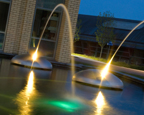 |
Christopher Wakefield Fountains of the CAPE This photograph was taken during a walk around the west Cambridge site. To create the effect of a smooth stream of water a 10 second exposure was required. This also had the effect of emphasising the Total Internal Reflection taking place inside the water. in editing the photo I cropped some of the image before removing some of the image noise. Finally a small amount of burning was used to correct over-exposed areas. What I particularly like is that by using a long exposure the fountain can be seen in a way that would not be available otherwise. Click on the image to see a larger version. |
|
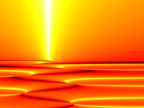 |
Christophe Lecomte Horizon "This picture represents mathematical characteristics of a very simple vibrating system. It has been generated by using a numerical software, Matlab, and no treatment has been applied to the raw data. Although the pictures are two dimensional, an impression of perspective dominates. Apparent valleys and hills cross paths to create a landscape on which a vertical ray of light is closing. The maps are used to predict the statistical properties of systems of which some components are random. A general stochastic theory has been developed that may be used for any linear system not only in engineering, but also in other fields like finance or physics." Click on the image to see a larger version. |
|
 |
Anne Bahnweg The Wing A single wing of the same fly photo taken with the scanning electron microscope (SEM). The pictures were not modified or edited in any way. They were taken straight out of the SEM. Click on the image to see a larger version. |
|
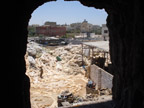 |
Andreas Petsas View into a different reality The photograph was taken during a recycling project in Jordan. The factory in the picture is situated a few km outside Amman and is recycling scrap plastic. The working conditions I witnessed through a shop window were quite shocking and made me put all that I've learnt about manufacturing in the UK into perspective. These men are usually Egyptian immigrants who work for a few hundred pounds a month in a dangerous working environment, full of toxic fumes where they are required to carry out hard manual tasks. Click on the image to see a larger version. |
|
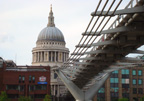 |
Andrea Maffioli The Millennium Bridge protrudes out of St Paul's The photo shows the Millennium Bridge in London and the details of its structure, including the innovative lateral suspension cables. St Paul's Cathedral, in the background, is an example of 300-year-old architecture and engineering from which the new bridge departs. Click on the image to see a larger version. |
|
 |
Dick Fenner The answer my friend is blowing in the wind Two graduate students on the MPhil in Engineering for Sustainable Development visiting Bears Down Wind Farm in Cornwall operated by npower renewables (part of the RWE group). The photograph was taken during a recent Field Trip to study post-mining regeneration of Cornwall. Click on the image to see a larger version. |
|
 |
Oliver Hughes Take off The Photograph was taken during testing of Gyrolander, a rocket created during my Master's project this year. This rocket is actively stabilised using a novel control system which requires only one gyroscope. Unfortunately during testing the rocket motors used were faulty and produced some exciting results! Click on the image to see a larger version. |
|
 |
Chien-Wen Hsieh Blizzard Night Engineering This image was taken at an unexpected blizzard midnight during a trip at Sapporo, Japan, where the most civil maintenance and construction works are basically taken place at night, even in such sort of severe weather. While the dawn comes back, the urban runs as usual. Click on the image to see a larger version. |
|
 |
David Thorn Winding of a transformer A small transformer's secondary coil being wound. This forms part of the high frequency DC to HVDC link in the GB2 (Electrical Power) 3rd year project. Acknowledgements: My partner in the sub-team working on the DC-DC half of the project is Julian Granger-Bevan of Selwyn. Click on the image to see a larger version. |
|
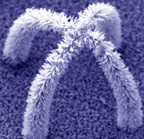 |
Mr Chi Li, Dr Yan Zhang, Mr Pritesh Hiralal, Dr Husnu Emrah Unalan and Dr Mark Mann Nano architecture The nano-structure is made up of carbon nanotube and zinc oxide nanowires. There are two growth steps: 1. vertical aligned carbon nanotubes array were grown on Si substate. 2. Zinc oxide nanowires were grown on the wall of the carbon nanotubes. The image was taken with a scanning electron microscope but is colour modified using the colour balance function in Adobe Photoshop. Click on the image to see a larger version. © Copyright notice You may copy an image from the photography competition, reproduce it, and distribute it, but only if you clearly attribute the image to the student or academic who took the photograph, state that they work in the Department of Engineering at the University of Cambridge, and acknowledge Nokia's sponsorship of the competition. It would also be courteous to provide a links to www.eng.cam.ac.uk and www.nokia.com. We would be delighted to hear where the images have been used. Please contact marketing@eng.cam.ac.uk to let us know. |
|
Photo Competition Archives |
| All previous year's photos can be found at: www.flickr.com/photos/cambridgeuniversity-engineering 2010 | 2009 | 2008 | 2007 | 2006 | 2005 | 2004 | |
| | Search | CUED | Cambridge University | Privacy policy | |
|
© Department of Engineering at the University of Cambridge Information provided by web-editor |